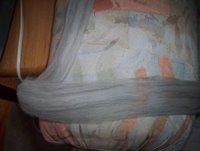

One of the things about spinning that was not adequated explained to me (or that I didn't adequately grasp) is the importance of fibre preparation. [If you are a new spinner, I recommend you viewing the video/DVDs available from Victorian Videos from Mabel Stowe or Patsy Zawistoski. These may be available from your guild or you can rent them.] I am not referring to washing raw fibre but what you should do with even the most commerical of tops or rovings or whathever the dealer sold it as. If you are processing wool yourself you will have all the steps of washing, drying, carding or combing or flicking but I am talking about commercially prepared roving. At the most basic when you take a hunk of roving to spin and pull off a section to spin (never cut), you sould again split it lengthwise, and sometimes split it again. Roving gets compressed for and during shipment taking all the air out of it and making the fibres try to stick together. The photo at left shows a length of my Brown Sheep mill end roving as pulled out of the bag, compressed. You could just twist the roving and get a form of thick rope that would hold together pretty well. Splitting it down to smaller sections opens it up. Then you should grasp the end in one hand and move the other hand a bit beyond the length of individual fibres and gently pull, drawing it out lengthwise. This will make it loads easier to spin. Go down the length of the segment and pull the whole way, lengthening the segment but not to the extent that you are pulling it apart, just letting the fibres slide past each other more easily. The photo at right shows the roving after being split and-pre-drafted; you can now see the pattern of my sofa through the wool. Then, depending how thoroughly your roving has been processed you can do what somebody called "monkey grooming". You've seen monkeys going over each other's fur, picking out what I shall call nasty bits. Your roving might need some grooming to remove noils (little balls of fibre that got tangled up in carding), and second cuts (short pieces of wool that occur where the shearer started and then went back for a second go at the fleece), and our beloved VM (vegetable matter). I am totally surprised that the Brown Sheep mill end roving I am spinning still has the occasional bit of weed or grass seed. I would have thought by this time there would be nothing left. Commercial wool scourers treat wool through a sulfuric acid process that should remove all VM. If your wool was processed at home or, even as we see in as commercial a business as Brown Sheep, there can still bit of grass. This is why Australian Quarantine is so leery about importing wool, and I don't blame them as one of those weed seeds could be a noxious pest that could cause millions of dollars to eradicate. So I pine for wool that I can only afford as raw fleece, and doesn't occur in Australia. Shetland, Icelandic, Wensleydale, Blue Faced Leicester... And here are the last 3 balls of discount Opal that arrived today. The centre one is really red, not pink.


1 comment:
Arrggghh (re: fibre prep). I'd been so long away from spinning and so eager to start up again that I forgot to do that. ("Olive Garden" romney and mohair, lovely hand, tasty color - couldn't resist jumping right in). Thank you, teacher.
Post a Comment